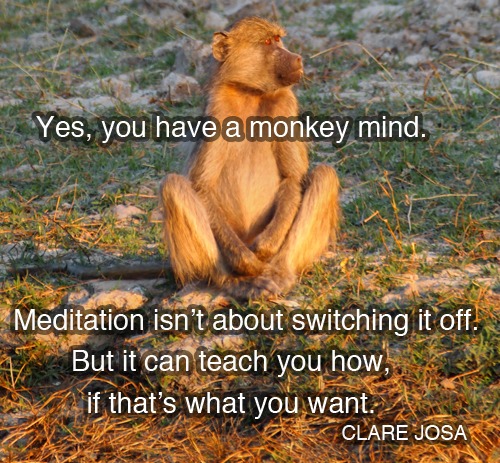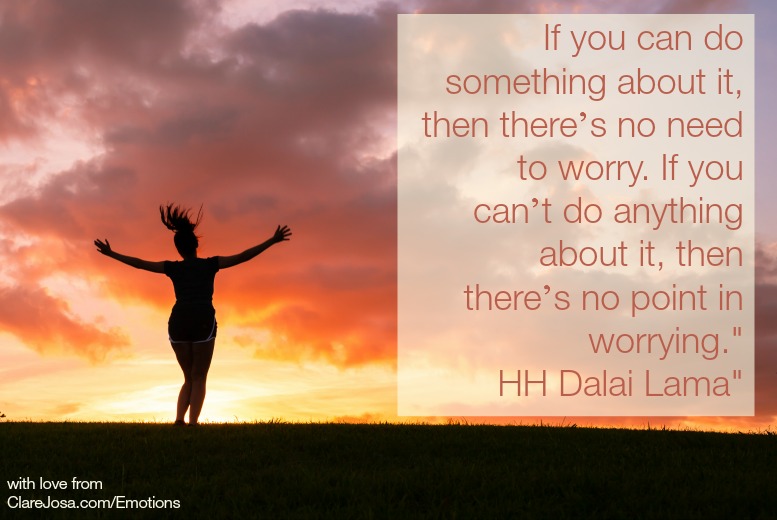As a professional meditation teacher, I have lost count of the number of times people have thrown the #1 meditation myth back at me. And, if I’m being really honest, I’ve used it myself as an excuse not to meditate.
But regular meditation and mindfulness are so good for you – even just 10 minutes a day – that I thought I would dispel the #1 myth for you. That way you can either dive in and get meditating – or work on some new excuses to throw at me 😉
The #1 Meditation Myth: “But I can’t shut up my mind!”
There are different ways of saying it:
- I don’t have an off switch.
- My mind is too chattering.
- My mind multi-tasks.
- How on earth can I meditate, if I can’t make my mind go quiet?
- As soon as I sit still, my mind takes over.
Well, it’s a myth. And it’s an excuse we often use, to get out of ‘having to’ meditate. But:
You don’t have to shut up your mind and stop thinking to be able to meditate.
You don’t have to be able to shut up your mind, to meditate.
Many expert meditators can’t do that yet. Some people find it easy. But the fact is that most of us have got monkey minds or grasshopper minds, leaping from one thing to the next. And there’s more to meditation than an empty mind.
You don’t have to make your mind go silent to be able to benefit from meditation.
If that’s what you’re aiming for, you’re likely to be disappointed. Just think about how many decades your mind has been taught to chatter. Yes, you can quieten your thoughts and slow things down with simple techniques that we’ll be covering during the next four weeks. But if you’re aiming for total ‘mind-silence’, then you’re setting yourself an extremely high standard to reach.
One of the keys to meditating well – or enjoying mindfulness practice – is to accept your mind. It’s about setting yourself free from being attached to your thoughts, so you are better placed to choose thoughts that create inner peace and happiness, rather than stress and anger. You don’t need to shut up your mind, to be able to meditate.
In fact:
Meditation is one of the processes that allows you to quieten your mind, so it is really the other way round!
Myth busted?
Strange though it may seem, having a monkey mind that chatters can actually be a bonus when you are first starting meditation, because you will quickly notice how 10 minutes a day of meditation can help quieten your mind. It takes dedication and it takes practice, just like any skill, but you will see results, even in the first few weeks.So how on earth are you supposed to meditate with your mind racing? Well, there are three keys to meditation.
- The first one is relaxation.
You can’t meditate if you’re feeling exhausted and stressed. It’s a simple fact that when we are tired and stressed we are running on adrenalin – and meditation is about creating a sense of calm.
You can’t do that if you’re in your ‘fight or flight’ stress mode. That’s why you’ll notice that, at the beginning of each meditation audio, there is a sequence that allows you to settle in the moment; to settle in your body and to start to relax.
It is critical that you let go and do that.
. - The second key is acceptance.
Your mind will wander: it will think about the shopping; it will think about the ironing; it will think about the school run; it will think about anything it can, because it is used to doing that.
That’s the job that it has had for so many years.
Don’t judge it; don’t dive into a story complaining to it about it getting in the way of your meditation, because suddenly your 10 minutes will be over. And you’re likely to feel that you wasted your time.
Don’t give up if your mind wanders. Just gently bring yourself back to whatever it is that you are focusing on in that day’s meditation.
Learning to accept the monkey mind is one of the most amazing ways to de-stress and calm down. It makes a huge difference to your meditation journey. It takes practice, but it is achievable.
The same thing goes for aches and pains, noises and interruptions. If you practise meditation daily, you will be learning how to accept them and not let them get in the way.
.
. - The third key to meditation is concentration and focus.
You’ll be learning how to concentrate and focus on just one thing at a time, to deepen your meditation.
In our multi-tasking life that can feel like a real challenge – and our conscious mind might give us all sorts of reasons why we can’t do it. The key is to choose whether or not you want to buy into those reasons – or whether you want to allow the process of practising meditation to help you make changes in your life.
For those of you on my How To Meditate course, over the 10 weeks we don’t just look at how to meditate, we also dive in and deal with:
- how to handle your thoughts getting in the way
- how to calm and quieten your mind
- how to allow your mind to relax
- and how to accept those thoughts
So you see, meditation is not about switching off your monkey mind. But if that’s what you want to do, it teaches you how.
Meditation is about learning to get your mind to work with you – gently training it – and that can be fun.
So I’m curious: what are you favourite meditation excuses?
Which myths are you feeding, to avoid 10 minutes a day of potentially life-changing silent sitting?
And what would I have to say to convince you to let go, trust and give it a try?
I’d love to hear from you via the comments!
With love, Namaste,
![]()
P.S. If you’d like to learn how to meditate, how about joining us for “How To Meditate“?
And if you’d love to know how to grow your business or transform your career with meditation, here’s a free webinar for you. xx Clare





